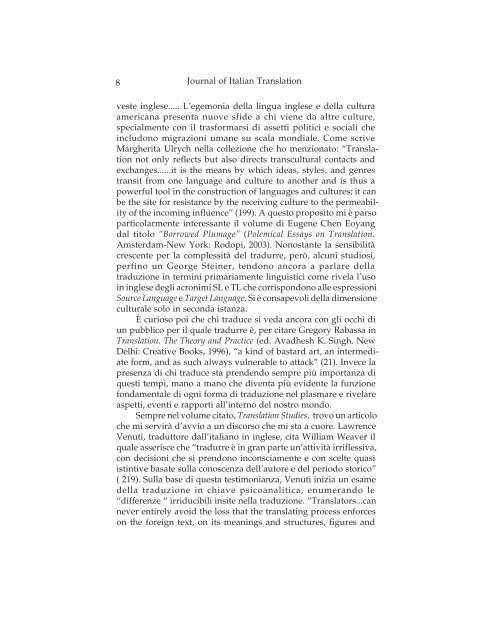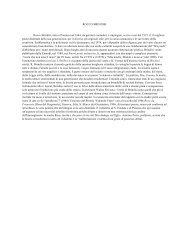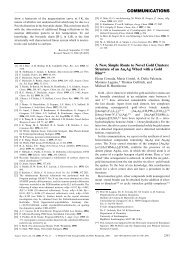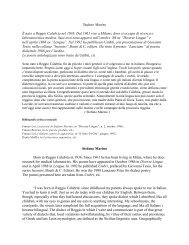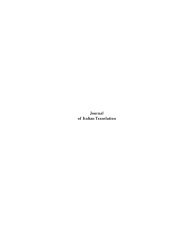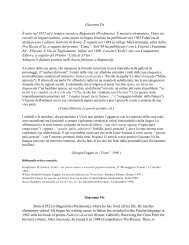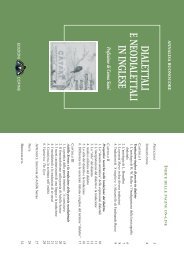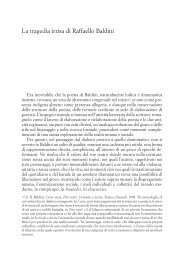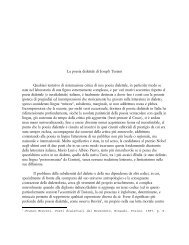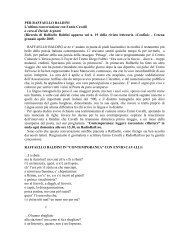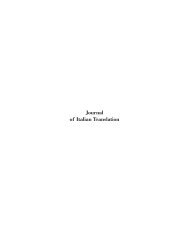Journal of Italian Translation
Journal of Italian Translation
Journal of Italian Translation
You also want an ePaper? Increase the reach of your titles
YUMPU automatically turns print PDFs into web optimized ePapers that Google loves.
8<br />
<strong>Journal</strong> <strong>of</strong> <strong>Italian</strong> <strong>Translation</strong><br />
veste inglese..... L’egemonia della lingua inglese e della cultura<br />
americana presenta nuove sfide a chi viene da altre culture,<br />
specialmente con il trasformarsi di assetti politici e sociali che<br />
includono migrazioni umane su scala mondiale. Come scrive<br />
Margherita Ulrych nella collezione che ho menzionato: “<strong>Translation</strong><br />
not only reflects but also directs transcultural contacts and<br />
exchanges......it is the means by which ideas, styles, and genres<br />
transit from one language and culture to another and is thus a<br />
powerful tool in the construction <strong>of</strong> languages and cultures; it can<br />
be the site for resistance by the receiving culture to the permeability<br />
<strong>of</strong> the incoming influence” (199). A questo proposito mi è parso<br />
particolarmente interessante il volume di Eugene Chen Eoyang<br />
dal titolo “Borrowed Plumage” (Polemical Essays on <strong>Translation</strong>.<br />
Amsterdam-New York: Rodopi, 2003). Nonostante la sensibilità<br />
crescente per la complessità del tradurre, però, alcuni studiosi,<br />
perfino un George Steiner, tendono ancora a parlare della<br />
traduzione in termini primariamente linguistici come rivela l’uso<br />
in inglese degli acronimi SL e TL che corrispondono alle espressioni<br />
Source Language e Target Language. Si è consapevoli della dimensione<br />
culturale solo in seconda istanza.<br />
È curioso poi che chi traduce si veda ancora con gli occhi di<br />
un pubblico per il quale tradurre è, per citare Gregory Rabassa in<br />
<strong>Translation</strong>. The Theory and Practice (ed. Avadhesh K. Singh. New<br />
Delhi: Creative Books, 1996), “a kind <strong>of</strong> bastard art, an intermediate<br />
form, and as such always vulnerable to attack” (21). Invece la<br />
presenza di chi traduce sta prendendo sempre più importanza di<br />
questi tempi, mano a mano che diventa più evidente la funzione<br />
fondamentale di ogni forma di traduzione nel plasmare e rivelare<br />
aspetti, eventi e rapporti all’interno del nostro mondo.<br />
Sempre nel volume citato, <strong>Translation</strong> Studies, trovo un articolo<br />
che mi servirà d’avvío a un discorso che mi sta a cuore. Lawrence<br />
Venuti, traduttore dall’italiano in inglese, cita William Weaver il<br />
quale asserisce che “tradurre è in gran parte un’attività irriflessiva,<br />
con decisioni che si prendono inconsciamente e con scelte quasi<br />
istintive basate sulla conoscenza dell’autore e del periodo storico”<br />
( 219). Sulla base di questa testimonianza, Venuti inizia un esame<br />
della traduzione in chiave psicoanalitica, enumerando le<br />
“differenze “ irriducibili insite nella traduzione. “Translators...can<br />
never entirely avoid the loss that the translating process enforces<br />
on the foreign text, on its meanings and structures, figures and


